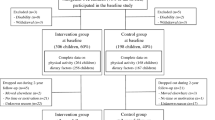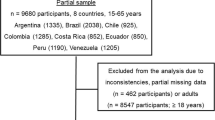Abstract
Purpose
To identify lifestyle patterns associated with blood lipid levels in children.
Methods
A representative sample of 2,043 schoolchildren (9–13 years) participated in a cross-sectional epidemiologic study conducted in 77 primary schools in four large regions in Greece. Dietary intakes, breakfast patterns and eating frequency, physical activity levels, sleep duration, anthropometric and physical examination data, biochemical indices and socioeconomic information (collected from parents) were assessed in all children. Principal component analysis was used to identify the lifestyle patterns.
Results
A lifestyle pattern of more screen time, shorter sleep duration and higher sugar-sweetened beverage consumption was inversely associated with HDL cholesterol (β = −0.077; P < 0.001) and positively associated with total/HDL cholesterol ratio (β = 0.049; P = 0.025). Furthermore, a lifestyle pattern of more eating occasions and higher moderate-to-vigorous physical activity (MVPA) levels was inversely associated with total cholesterol (β = −0.064; P = 0.006), LDL (low-density lipoprotein) cholesterol (β = −0.065; P = 0.004) and total/HDL (high-density lipoprotein) cholesterol ratio (β = −0.043; P = 0.049) in multivariate models. Finally, children with MVPA levels and eating frequency higher than that corresponding to the second quartile of this lifestyle pattern (i.e., > 44.8 min of MVPA per day and > 4.7 meals per day) were 29.7, 32.6 and 43.1 % less likely of having abnormal levels of total cholesterol, LDL and total/HDL cholesterol ratio, respectively, according to the National Cholesterol Education Program (NCEP) cutoff points.
Conclusions
A lifestyle pattern of more than approximately 45 min of MVPA and 5 eating occasions per day was significantly associated with reduced likelihood of dyslipidemias in schoolchildren (9–13 years).
Similar content being viewed by others
References
Daniels SR, Arnett DK, Eckel RH, Gidding SS, Hayman LL, Kumanyika S, Robinson TN, Scott BJ, St Jeor S, Williams CL (2005) Overweight in children and adolescents: pathophysiology, consequences, prevention, and treatment. Circulation 111:1999–2012
Berenson GS, Srinivasan SR, Bao W, Newman WP 3rd, Tracy RE, Wattigney WA (1998) Association between multiple cardiovascular risk factors and atherosclerosis in children and young adults. The Bogalusa Heart Study. N Engl J Med 338:1650–1656
Raitakari OT, Juonala M, Kahonen M, Taittonen L, Laitinen T, Maki-Torkko N, Jarvisalo MJ, Uhari M, Jokinen E, Ronnemaa T, Akerblom HK, Viikari JS (2003) Cardiovascular risk factors in childhood and carotid artery intima-media thickness in adulthood: the Cardiovascular Risk in Young Finns Study. JAMA 290:2277–2283
Jacques PF, Tucker KL (2001) Are dietary patterns useful for understanding the role of diet in chronic disease? Am J Clin Nutr 73:1–2
Mikkila V, Rasanen L, Raitakari OT, Marniemi J, Pietinen P, Ronnemaa T, Viikari J (2007) Major dietary patterns and cardiovascular risk factors from childhood to adulthood. The Cardiovascular Risk in Young Finns Study. Br J Nutr 98:218–225
Moschonis G, Tanagra S, Vandorou A, Kyriakou AE, Dede V, Siatitsa PE, Koumpitski A, Androutsos O, Grammatikaki E, Kantilafti M, Naoumi A, Farmaki AE, Siopi A, Papadopoulou EZ, Voutsadaki E, Chlouveraki F, Maragkopoulou K, Argyri E, Giannopoulou A, Manios Y (2011) Social, economic and demographic correlates of overweight and obesity in primary-school children: preliminary data from the Healthy Growth Study. Public Health Nutr 13:1693–1700
Owen CG, Nightingale CM, Rudnicka AR, Sattar N, Cook DG, Ekelund U, Whincup PH (2010) Physical activity, obesity and cardiometabolic risk factors in 9- to 10-year-old UK children of white European, South Asian and black African-Caribbean origin: the Child Heart And health Study in England (CHASE). Diabetologia 53:1620–1630
Spruyt K, Molfese DL, Gozal D (2011) Sleep duration, sleep regularity, body weight, and metabolic homeostasis in school-aged children. Pediatrics 127:e345–e352
Trichopoulou A (2004) Composition tables of foods and Greek dishes. School of Medicine: Department of Hygiene and Epidemiology, Athens
Nicklas TA, Webber LS, Srinivasan SR, Berenson GS (1993) Secular trends in dietary intakes and cardiovascular risk factors of 10-y-old children: the Bogalusa Heart Study (1973–1988). Am J Clin Nutr 57:930–937
Nicklas TA, Farris RP, Johnson CC, Webber LS, Berenson GS (1990) Food sources of nutrients: a tool for dietary management and health. The Bogalusa Heart Study 1973–1983. National center for cardiovascular health, Louisiana, New Orleans
Giovannini M, Verduci E, Scaglioni S, Salvatici E, Bonza M, Riva E, Agostoni C (2008) Breakfast: a good habit, not a repetitive custom. J Int Med Res 36:613–624
Manios Y, Kafatos A, Markakis G (1998) Physical activity in 6-year-old children: validation of two proxy reports. Pediatr Exerc Sci 10:176–188
Craig SB, Bandini LG, Lichtenstein AH, Schaefer EJ, Dietz WH (1996) The impact of physical activity on lipids, lipoproteins, and blood pressure in preadolescent girls. Pediatrics 98:389–395
Basterfield L, Pearce MS, Adamson AJ, Frary JK, Parkinson KN, Wright CM, Reilly JJ (2012) Physical activity, sedentary behavior, and adiposity in English children. Am J Prev Med 42:445–451
Cole TJ, Flegal KM, Nicholls D, Jackson AA (2007) Body mass index cut offs to define thinness in children and adolescents: international survey. BMJ 335:194
Cole TJ, Bellizzi MC, Flegal KM, Dietz WH (2000) Establishing a standard definition for child overweight and obesity worldwide: international survey. BMJ 320:1240–1243
Tanner JM (1955) Growth at adolescence. Blackwell Scientific, Oxford
Friedewald WT, Levy RI, Fredrickson DS (1972) Estimation of the concentration of low-density lipoprotein cholesterol in plasma, without use of the preparative ultracentrifuge. Clin Chem 18:499–502
American Academy of Pediatrics (1992) National Cholesterol Education Program: report of the expert panel on blood cholesterol levels in children and adolescents. Pediatrics 89:525–584
Magkos F, Manios Y, Christakis G, Kafatos AG (2005) Secular trends in cardiovascular risk factors among school-aged boys from Crete, Greece, 1982–2002. Eur J Clin Nutr 59:1–7
Tzotzas T, Kapantais E, Tziomalos K, Ioannidis I, Mortoglou A, Bakatselos S, Kaklamanou M, Lanaras L, Kaklamanou D (2011) Prevalence of overweight and abdominal obesity in Greek children 6–12 years old: results from the national epidemiological survey. Hippokratia 15:48–53
Farajian P, Risvas G, Karasouli K, Pounis GD, Kastorini CM, Panagiotakos DB, Zampelas A (2011) Very high childhood obesity prevalence and low adherence rates to the Mediterranean diet in Greek children: the GRECO study. Atherosclerosis 217(2):525–530
Manios Y, Costarelli V, Kolotourou M, Kondakis K, Tzavara C, Moschonis G (2007) Prevalence of obesity in preschool Greek children, in relation to parental characteristics and region of residence. BMC Public Health 7:178
Guerrero-Romero F, Rodriguez-Moran M (2006) Prevalence of dyslipidemia in non-obese prepubertal children and its association with family history of diabetes, high blood pressure, and obesity. Arch Med Res 37:1015–1021
Jago R, Harrell JS, McMurray RG, Edelstein S, El Ghormli L, Bassin S (2006) Prevalence of abnormal lipid and blood pressure values among an ethnically diverse population of eighth-grade adolescents and screening implications. Pediatrics 117:2065–2073
Rodriguez-Moran M, Salazar-Vazquez B, Violante R, Guerrero-Romero F (2004) Metabolic syndrome among children and adolescents aged 10–18 years. Diabetes Care 27:2516–2517
Briefel RR, Wilson A, Gleason PM (2009) Consumption of low-nutrient, energy-dense foods and beverages at school, home, and other locations among school lunch participants and nonparticipants. J Am Diet Assoc 109:S79–S90
Kavey RE (2010) How sweet it is: sugar-sweetened beverage consumption, obesity, and cardiovascular risk in childhood. J Am Diet Assoc 110:1456–1460
Dhingra R, Sullivan L, Jacques PF, Wang TJ, Fox CS, Meigs JB, D’Agostino RB, Gaziano JM, Vasan RS (2007) Soft drink consumption and risk of developing cardiometabolic risk factors and the metabolic syndrome in middle-aged adults in the community. Circulation 116:480–488
Gangwisch JE, Malaspina D, Babiss LA, Opler MG, Posner K, Shen S, Turner JB, Zammit GK, Ginsberg HN (2010) Short sleep duration as a risk factor for hypercholesterolemia: analyses of the National Longitudinal Study of Adolescent Health. Sleep 33:956–961
Danielsen YS, Juliusson PB, Nordhus IH, Kleiven M, Meltzer HM, Olsson SJ, Pallesen S (2011) The relationship between life-style and cardio-metabolic risk indicators in children: the importance of screen time. Acta Paediatr 100:253–259
Mark AE, Janssen I (2008) Relationship between screen time and metabolic syndrome in adolescents. J Public Health (Oxf) 30:153–160
Craggs C, Corder K, van Sluijs EM, Griffin SJ (2011) Determinants of change in physical activity in children and adolescents: a systematic review. Am J Prev Med 40:645–658
Mann J (1997) Meal frequency and plasma lipids and lipoproteins. Br J Nutr 77(Suppl 1):S83–S90
Bhutani S, Varady KA (2009) Nibbling versus feasting: which meal pattern is better for heart disease prevention? Nutr Rev 67:591–598
Overby NC, Margeirsdottir HD, Brunborg C, Dahl-Jorgensen K, Andersen LF (2008) Sweets, snacking habits, and skipping meals in children and adolescents on intensive insulin treatment. Pediatr Diabetes 9:393–400
O’Donovan G, Blazevich AJ, Boreham C, Cooper AR, Crank H, Ekelund U, Fox KR, Gately P, Giles-Corti B, Gill JM, Hamer M, McDermott I, Murphy M, Mutrie N, Reilly JJ, Saxton JM, Stamatakis E (2010) The ABC of physical activity for health: a consensus statement from the British Association of Sport and Exercise Sciences. J Sports Sci 28:573–591
Agostoni C, Braegger C, Decsi T, Kolacek S, Koletzko B, Mihatsch W, Moreno LA, Puntis J, Shamir R, Szajewska H, Turck D, van Goudoever J (2011) Role of dietary factors and food habits in the development of childhood obesity: a commentary by the ESPGHAN Committee on Nutrition. J Pediatr Gastroenterol Nutr 52:662–669
Smith KJ, Gall SL, McNaughton SA, Blizzard L, Dwyer T, Venn AJ (2010) Skipping breakfast: longitudinal associations with cardiometabolic risk factors in the Childhood Determinants of Adult Health Study. Am J Clin Nutr 92:1316–1325
Acknowledgments
This research has been co-financed by the European Union (European Social Fund—ESF) and Greek national funds through the Operational Program “Education and Lifelong Learning” of the National Strategic Reference Framework (NSRF)—Research Funding Program: Heracleitus II—investing in knowledge society through the European Social Fund. The authors would also like to thank the “Healthy Growth Study” group for the valuable contribution to the completion of the study.
Conflict of interest
None of the authors has any conflict of interest to declare.
Author information
Authors and Affiliations
Corresponding author
Additional information
This study is on behalf of the “Healthy Growth Study” group.
The details of the “Healthy Growth Study” are given in the “Appendix.”
Appendix
Appendix
Healthy Growth Study Group
1. Harokopio University Research Team/Department of Nutrition and Dietetics: Yannis Manios (Coordinator), George Moschonis (Project manager), Katerina P. Skenderi, Evangelia Grammatikaki, Odysseas Androutsos, Sofia Tanagra, Alexandra Koumpitski, Paraskevi-Eirini Siatitsa, Anastasia Vandorou, Aikaterini-Efstathia Kyriakou, Vasiliki Dede, Maria Kantilafti, Aliki-Eleni Farmaki, Aikaterini Siopi, Sofia Micheli, Louiza Damianidi, Panagiota Margiola, Despoina Gakni, Vasiliki Iatridi, Christina Mavrogianni, Kelaidi Michailidou, Aggeliki Giannopoulou, Efstathoula Argyri, Konstantina Maragkopoulou, Maria Spyridonos, Eirini Tsikalaki, Panagiotis Kliasios, Anthi Naoumi, Konstantinos Koutsikas, Katerina Kondaki, Epistimi Aggelou, Zoi Krommyda, Charitini Aga, Manolis Birbilis, Ioanna Kosteria, Amalia Zlatintsi, Elpida Voutsadaki, Eleni-Zouboulia Papadopoulou, Zoi Papazi, Maria Papadogiorgakaki, Fanouria Chlouveraki, Maria Lyberi, Nora Karatsikaki-Vlami, Eva Dionysopoulou, Efstratia Daskalou.
2. Aristotle University of Thessaloniki/School of Physical Education and Sports Science: Vassilis Mougios, Anatoli Petridou, Konstantinos Papaioannou, Georgios Tsalis, Ananis Karagkiozidis, Konstantinos Bougioukas, Afroditi Sakellaropoulou, Georgia Skouli.
3. University of Athens/ Medical School: George P. Chrousos, Maria Drakopoulou, Evangelia Charmandari, Neni Pervanidou.
Rights and permissions
About this article
Cite this article
Moschonis, G., Mavrogianni, C., Karatzi, K. et al. Increased physical activity combined with more eating occasions is beneficial against dyslipidemias in children. The Healthy Growth Study. Eur J Nutr 52, 1135–1144 (2013). https://doi.org/10.1007/s00394-012-0424-3
Received:
Accepted:
Published:
Issue Date:
DOI: https://doi.org/10.1007/s00394-012-0424-3




